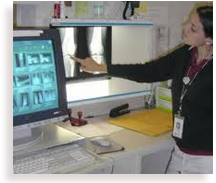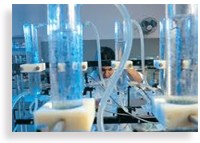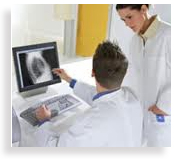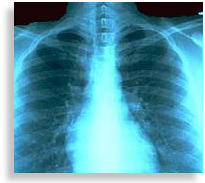RADIOGRAPHY
Introduction to the Career
Radiography is mostly the modern medical technology used to diagnose the ailment and diseases of the internal parts of the body using X-ray, Fluoroscopy, Ultrasound, CTscan, MRI, Angiography and PET technologies. It helps in getting a detailed image of internal body parts and their functioning. By using this, a doctor can easily diagnose the disease and can suggest effective treatment procedure. There are two types of radiography: diagnostic and therapeutic. Diagnostic radiography is concerned with operating radio imaging machines and interpreting results. But therapeutic radiography involves treatment of cancers, ulcer and tumors with the help of radiation technology. Correct diagnosis is important for providing exact treatment for a disease.For some ailments it is not possible to find out the diseases by the symptoms alone.
PET is a nuclear medicine medical imaging, a branch of medicine and medical imaging that uses unsealed radioactive substances in diagnosis and therapy, which produces a three dimensional image of the functional processes in the body.Unless we get a detailed image of internal body parts and what is happening in the body the treatment will not be effective. Radiography is mainly concerned with operating radio imaging machines such as X-ray and interpreting results.
It also involves treatment of cancers and tumors with radiation. There are two career choices in the field- Diagnostic Radiography and Therapeutic Radiography. The main responsibility of the Diagnostic radiographer is to explain the procedure to the patients, prepare them for the tests and operate the machine, and do the maintenance of equipment and records. They also assist physicians in performing procedures such as Myelograms (an exam to detect injuries, Cysts or tumours in the spinal cord) and surgeons in the operating room with portable x-ray machines or fluoroscopic machines.Therapeutic radiography or Radiotherapy is now being used in the treatment and diagnosis of a large number of diseases, including cancer, tumors and ulcers. A therapy radiographer uses radiation in highly controlled conditions in the treatment of tumor. Exact amount of radiation will shrink the tumour. The need for professionals in the field of radiography is increasing. A radiographer is also called Radiologic technologist who has to handle the equipments and upgrade their skills now and then as technology advances. As more sophisticated newer machines are coming up and experts in this career is less, there is an increase in the need for radiographers.
Nature of Work and Job Description
Radiological technicians specialize in radiography, radiation therapy, sonogram, and nuclear medicine. Each of these areas is specialized and the training and work is conducted under the supervision of specialist physicians. The administrative tasks here mainly includes maintaining patient records as well as the usage of the equipment.Radiographers work with Radiologists and Ultrasonologist in carrying out the routine work like taking Xrays, CTscans, and MR scans of patients.

Top Recruiting Companies
There is currently a strong demand for diagnostic radiographers, both in the public and private sector in India. Graduates have the opportunity to accept positions in capital cities, rural and remote locations and, internationally. Diagnostic radiographers have the opportunity to work in a variety of medical imaging clinical environments, some of which are general in nature and provide a broad spectrum of imaging modalities and patient presentations.

Eligibility
Qualifications

Desired and Essential Skills:
Radiography is essentially a service oriented field. Patience, a calm temperament, an objective approach towards the patients and an understanding of people of all ages, the ability to infuse confidence in patients, tolerance, a strong willpower, strength of mind and purpose are essential for people aspiring to make a career in the field. Other skills required are a strong scientific and technical bent of mind, the ability to learn new skills and adapt to the changes, communication skills and a spirit for teamwork, good powers of observation, accurate judgment and self-confidence
Job Prospects
There are a lot of job opportunities for radiographers inside the country as well as internationally. In India there are a lot of jobs in health services. Radiographers are required in large numbers in nursing homes, hospitals, diagnostic centers and super speciality hospitals. The job of a radiographer also covers areas like medicine, research and teaching. The field of nuclear medicine and photography are also open to x-ray technicians and radiographers. Radiographers have to make high quality images which in turn will help to diagnose disease and injury. They are employed in the X-ray and ultrasound departments of medical institutions and clinics.
Radiographers have to work in diagnostic imaging department, intensive care unit, operating theatre, along with doctors and other hospital staff. In short they have to work as a team.The following job profiles also comes under radiography
Radio Diagnosis: It is the method of diagnosing the patient's illness with the help of X-ray, ultrasound or other such equipment.
Radio Therapy: A therapy radiographer treat patients with tumour, using radiation in highly controlled conditions.
Radiation Protection: Specialists in this area monitor the levels of radiation exposure and thereby ensure that no one is over-exposed to these radiations, which could prove to be extremely harmful.
Remuneration

Courses
- B.Sc. (Hons.) Medical Technology in Radiology
- B.Sc. Medical Imaging Technology
- B.Sc. Medical Tech. (X-Ray)
- B.Sc. Radiography
- B.Sc. Radiography
- Certificate Course in Dark Room Assistant
- Certificate Course in Radiography
- Certificate Course in Radiography Diagnostic
- Certificate Course in Radiological Assistant
- Certificate Course in X-ray Technician
- Diploma in Medical Radiation Tech. (Diag.)
- Diploma in Medical Radiation Technician (Nuc. Med)
- Diploma in Medical Radiation Technician (Therapy)
- Diploma in Radio diagnostic Technology
- Diploma in Radiography and Radiotherapy
- Diploma in X-Ray Assistant
- Diploma in X-ray Imaging Technology (DXIT)
- Diploma in X-Ray Technician
- Post Graduate Diploma in Imaging Technology
- Post Graduate Diploma in Radio Diagnosis and Imaging Sciences
- Post Graduate Diploma in Radio Therapy Technology
Institutes
Radiography |
Experts Opinion
According to experts in the field, this is a b oom time for qualified radiologists. Indian radiologists are increasingly receiving work from the US, Europe and elsewhere. Therefore contemporary radiologists need to be computer literate in this technology intensive specialization. Radiology has become an attractive career choice of young people. The first point in the line of a medical investigation, it plays a very critical role in medicine. "Technology developments in this field are fast and furious, which is why today it is the number one specialization choice for MBBS graduates," says Dr. Dhaval Modi, who was the head of the department of radio diagnosis, neuro-radiology and interventional radiology at the highly reputed Bombay Hospital and Medical Research Centre (estb. 1952), since 1994.
A major breakthrough in this field - teleradiology i.e electronic transmission of radiological images such as x-rays, CTs and MRIs from one location to another for interpretation and consultation - has spurred the demand for qualified radiologists. Consequently people across the world including the remotest parts of India, can get the expert opinion of best radiologists.Since India boasts a large pool of well-trained doctors and is simultaneously experiencing an ICT (information communication technology) revolution, it is gradually emerging as a tele-radiology hub. Indian radiologists are increasingly receiving work outsourced to them from the US, Europe, Singapore and the Middle East. Therefore one of the important attributes of a contemporary radiologist is computer literacy, as this specialization has become technology intensive.
